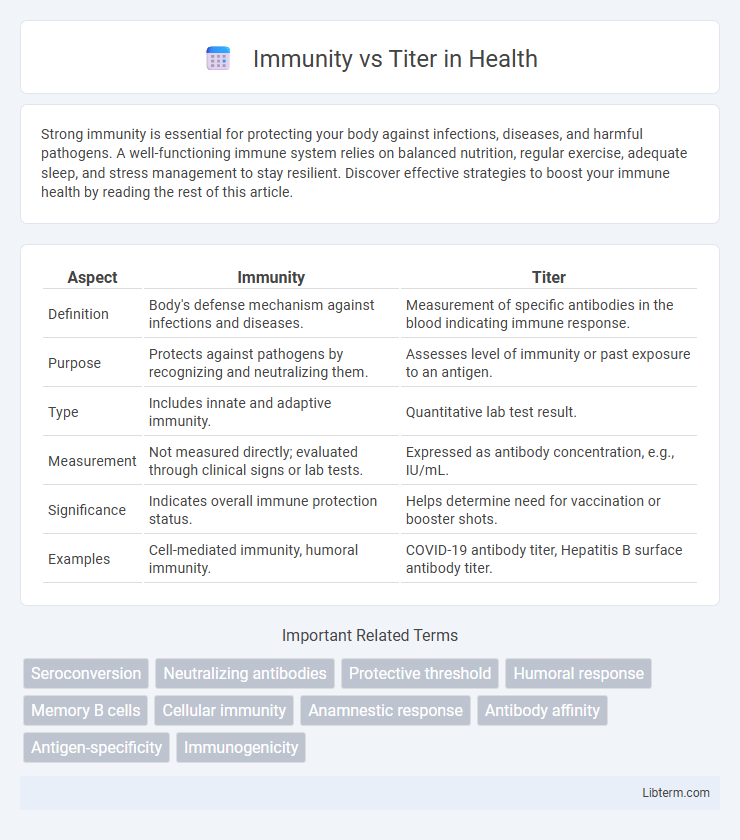Strong immunity is essential for protecting your body against infections, diseases, and harmful pathogens. A well-functioning immune system relies on balanced nutrition, regular exercise, adequate sleep, and stress management to stay resilient. Discover effective strategies to boost your immune health by reading the rest of this article.
Table of Comparison
| Aspect | Immunity | Titer |
|---|---|---|
| Definition | Body's defense mechanism against infections and diseases. | Measurement of specific antibodies in the blood indicating immune response. |
| Purpose | Protects against pathogens by recognizing and neutralizing them. | Assesses level of immunity or past exposure to an antigen. |
| Type | Includes innate and adaptive immunity. | Quantitative lab test result. |
| Measurement | Not measured directly; evaluated through clinical signs or lab tests. | Expressed as antibody concentration, e.g., IU/mL. |
| Significance | Indicates overall immune protection status. | Helps determine need for vaccination or booster shots. |
| Examples | Cell-mediated immunity, humoral immunity. | COVID-19 antibody titer, Hepatitis B surface antibody titer. |
Understanding Immunity: Definition and Types
Immunity refers to the body's ability to resist infections and diseases through specific defenses involving the immune system. It comprises two main types: innate immunity, which provides immediate, non-specific protection, and adaptive immunity, which develops targeted responses and memory after exposure to pathogens. Understanding the mechanisms of humoral and cell-mediated immunity is crucial for comprehending how the body identifies and neutralizes harmful antigens effectively.
What is Titer? Interpreting Antibody Levels
Titer refers to the measurement of specific antibodies in the blood, indicating the strength of an immune response to a particular antigen. Interpreting antibody levels involves assessing whether the titer is sufficient to provide immunity, with higher titers generally correlating with better protection against infections. Accurate titer evaluation helps determine the need for booster vaccinations or further medical intervention.
Immunity vs Titer: Key Differences Explained
Immunity refers to the body's ability to resist infections through a complex system of immune responses, while titer specifically measures the concentration of antibodies in the blood indicating immune status. Immunity encompasses both cellular and humoral defenses, whereas titer quantifies only the antibody levels. Understanding immunity versus titer is crucial for interpreting vaccine efficacy and monitoring protective immune responses.
How the Immune System Works
Immunity represents the body's ability to resist infections and diseases through a complex network of responses involving white blood cells, antibodies, and memory cells. A titer measures the concentration of specific antibodies in the blood, indicating the strength or presence of immunity against particular pathogens. The immune system's adaptive response increases antibody production, which is quantified by titers to assess immune protection levels.
Measuring Immunity: The Role of Titer Tests
Titer tests measure the concentration of specific antibodies in the blood, providing a quantifiable indication of immunity against infections or vaccination. These tests help determine whether an individual has sufficient immune protection or requires booster shots. By assessing antibody levels, healthcare providers can make informed decisions about immunization status and evaluate immune response effectiveness.
Factors Affecting Immune Response and Titers
Factors affecting immune response and titers include age, genetics, nutrition, and underlying health conditions, which influence antibody production and immune system efficiency. Vaccine type, dosage, and schedule also critically determine the magnitude and duration of antibody titers. Environmental exposures and previous infections shape immune memory, impacting both the quality and quantity of antibody responses measured by titers.
Clinical Significance: When Titers Matter
Titer measurements play a critical role in evaluating immunity by quantifying specific antibody levels against infections or vaccinations. Clinically, titers guide decisions on the need for booster doses, especially for diseases like measles, hepatitis B, and varicella where protective immunity correlates with established antibody thresholds. Understanding when titers indicate insufficient immunity is essential for preventing outbreaks and tailoring individualized immunization strategies.
Misconceptions About Immunity and Titer
Misconceptions about immunity and titer levels often arise from the belief that a specific antibody titer directly equates to complete immunity against an infection. However, immunity is a complex interplay of both humoral and cellular responses that a titer alone cannot fully represent. Relying solely on antibody titers may overlook memory immune responses and the protective role of T cells, leading to incomplete assessments of an individual's immune status.
Immunizations: Building Immunity and Monitoring Titers
Immunizations stimulate the immune system to produce antibodies, building lasting immunity against specific pathogens. Monitoring titers measures the concentration of these antibodies in the blood, indicating the strength and duration of immunity. Regular titer testing helps determine if booster vaccinations are needed to maintain effective protection.
Future Perspectives: Advances in Immunity and Titer Testing
Emerging technologies in immunity and titer testing are enhancing the precision and speed of detecting immune responses, enabling personalized vaccination schedules and improved disease management. Advances in high-throughput assays and biosensors facilitate real-time monitoring of antibody levels, contributing to better epidemiological surveillance and vaccine efficacy evaluation. Integration of artificial intelligence and machine learning algorithms promises to revolutionize predictive modeling of immunity duration and optimize booster shot recommendations.
Immunity Infographic

 libterm.com
libterm.com